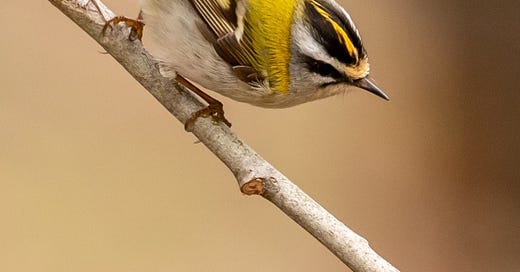The firecrest is a ‘birder’s bird’. Tiny, restless, exquisitely marked, and never common, a close encounter with a firecrest can make your day.
Although they are scarce, and mainly limited to the south and east of England for now, they do turn up in all kinds of places, and not just the ‘special bird spots’. During winter and migration seasons, they can increasingly be found in ones and twos around urban parks, on the messy edges of towns and villages and even in a few lucky gardens.
Despite their striking looks they can easily slip by unnoticed. Tuning into their contact calls greatly increases the chance of seeing one.
At first listen, the sounds they make are all Acme Small Bird - high-pitched twitterings that could easily be another pipsqueak such as a goldcrest or a blue tit.
Firecrest calls are generally made up of an unremarkable peeping note, given one at a time or in a rapid bunch.
But every once in a while they give themselves away, with a series of three or four notes that inflect upwards.
In this recording you can hear mainly one-note calls given quickly, and sounding rather anonymous - until towards the end you hear two phrases which make the characteristic ascent.
While undeniably subtle, it’s distinctive. Plenty of species deploy descending phrases, especially in song - think chaffinch, treecreeper, willow warbler, meadow pipit, woodlark. Not many head in the other direction.
In itself, that call is hardly a prize, but if it leads to a glimpse of what’s calling then you are a winner.
Firecrests share the title of smallest bird in Europe with their cousin the goldcrest. But whereas goldcrests have no eyestripe (and an endearingly nonplussed expression), firecrests look sharp - black through the eye, whiteish above and below it, and with a fiery, black-bordered streak on the crown.
Like goldcrests, adult females and males can be told apart by that crown - even golden yellow in the female, yellow with an orange centre in the male. But this is not always easy to tell in the field, not least because firecrests don’t keep still more than a nanosecond.
Firecrests like to fidget and flit their way through tangled places. For a moment they may appear right in front of you - peeking out from the edge of a thicket or hovering under a leaf to pick off a morsel.
Then they’re gone. Once again, tracking them by ear is often the best way to steal a second look.
If you’re in the right place, spring provides an opportunity to see firecrests keep still a little longer, when they sing. Since first being found nesting in the New Forest in 1962, firecrests have spread to other sites in the south east, where they’re drawn to woodland and parkland with a mix of evergreen and deciduous trees.
Their simple song is delivered among the boughs, well above head height. Like the contact call, it’s a high-pitched peeping, which accelerates and rises very slightly in pitch over the course of around three seconds.
The bird in the recording above has been singing near my home in recent days, in a suburban area busy with dog-walkers and cyclists, apparently unperturbed.
Perhaps it’s just practising and will move on as the weather warms up. But with several hundred pairs now breeding in the UK, and their range spreading gradually northwards, maybe it’s a sign of things to come for many more ordinary neighbourhoods.
And who wouldn’t want to be neighbours with a firecrest?
Next week: Chaffinch
There’s a Shriek of the Week every Friday. If you know someone who might like a dose of birdsong in their inbox, please pass this along.
You can now also support Shriek of the Week by becoming a paid subscriber. The main benefit is an ineffable sense of wellbeing, but you also get access to a narrated version of each email and an invitation to a monthly Early Bird Club call to listen to the dawn chorus together. It’s nice!
Join Birdsong Academy events this spring:
British Birdsong Essentials: the 10-week course starts next Friday 25 February
Up With The Birds: a free-to-all ‘virtual dawn chorus’ meeting on Zoom, 26 February and then monthly
Half-day birdsong ‘walkshops’ in Stanmer Park, Brighton: Fridays in March, April & May
Thanks for reading. May your shrubbery overflow with firecrests.
~ Charlie
Credits:
Photo by Kiril Gruev from Pexels




